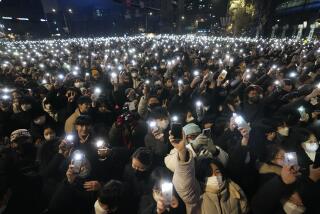A Kwanzaa Primer
- Share via
If you want to adhere strictly to the Kwanzaa program as Maulana (Ron) Karenga, chairman of black studies at Cal State Long Beach, conceived it, here is what you need.
1. Mazao : Fruits and vegetables, which stand for the product of unified effort.
2. Mkeka : A straw place mat, which represents the reverence for tradition.
3. Vivunzi : An ear of corn for each child in the family.
4. Zawadi : Simple gifts, preferably related to education or to things African or African-influenced.
5. Kikombe Cha Umoja : A communal cup for the libation (I like to look at this as a kind of homage to the past, present and future black Americans).
6. Kinara : A seven-branched candleholder, which symbolizes the continent and peoples of Africa.
7. Mishumaa Saba : The seven candles, each of which symbolizes one of the Nguzo Saba , or seven principles, that black Americans should live by on a daily basis and which are reinforced during Kwanzaa .
On each day of the Kwanzaa celebration, a family member lights a candle, then discusses one of those seven principles. The principles, along with Karenga’s elucidation of them in 1965, are:
1. Umoja (Unity): To strive for and maintain unity in the family, community, nation and race.
2. Kujichagulia (Self-Determination): To define ourselves, name ourselves, create for ourselves and speak for ourselves instead of being defined, named, created for and spoken for by others.
3. Ujima (Collective Work and Responsibility): To build and maintain our community together, and to make our sisters’ and brothers’ problems our problems and to solve them together.
4. Ujamma (Cooperative Economics): To build and maintain our own stores, shops and other businesses and to profit from them together.
5. Nia (Purpose): To make our collective vocation the building and developing of our community in order to restore our people to their traditional greatness.
6. Kuumba (Creativity): To do always as much as we can, in whatever way we can, in order to leave our community more beautiful and beneficial than we inherited it.
7. Imani (Faith): To believe with all our heart in our people, our parents, our teachers, our leaders and in the righteousness and victory of our struggle.
The next-to-last day of the holiday, Dec. 31 (many people do this on Jan. 1), is marked by a lavish feast, the Kwanzaa Karamu , which, in keeping with the theme of black unity, may draw on the cuisines of the Caribbean, Africa, South America . . . wherever Africans were taken.
In addition to food, the Karamu is an opportunity for a confetti storm of cultural expression--dance and music, readings, remembrances. Here is Karenga’s suggested way of conducting a Karamu , as enlarged upon by a New York City Kwanzaa celebrant, Cedric McClester. Each of the following is punctuated by some form of artistic expression of African or African-American heritage.
1. Kukaribisha (Welcoming): Introductory remarks and recognition of distinguished guests and elders.
2. Kukumbuka (Remembering): Reflections of a man, a woman and a child.
3. Kuchunguza Tena Na Kutoa Ahadi Tena (Reassessment and Recommitment): Introduction of distinguished guest lecturer and short talk.
4. Kushangilia (Rejoicing): Includes the pouring of a libation from the communal cup, a libation statement, the calling names of family ancestors and black heroes, drums and the feast.
5. A Farewell Statement.


